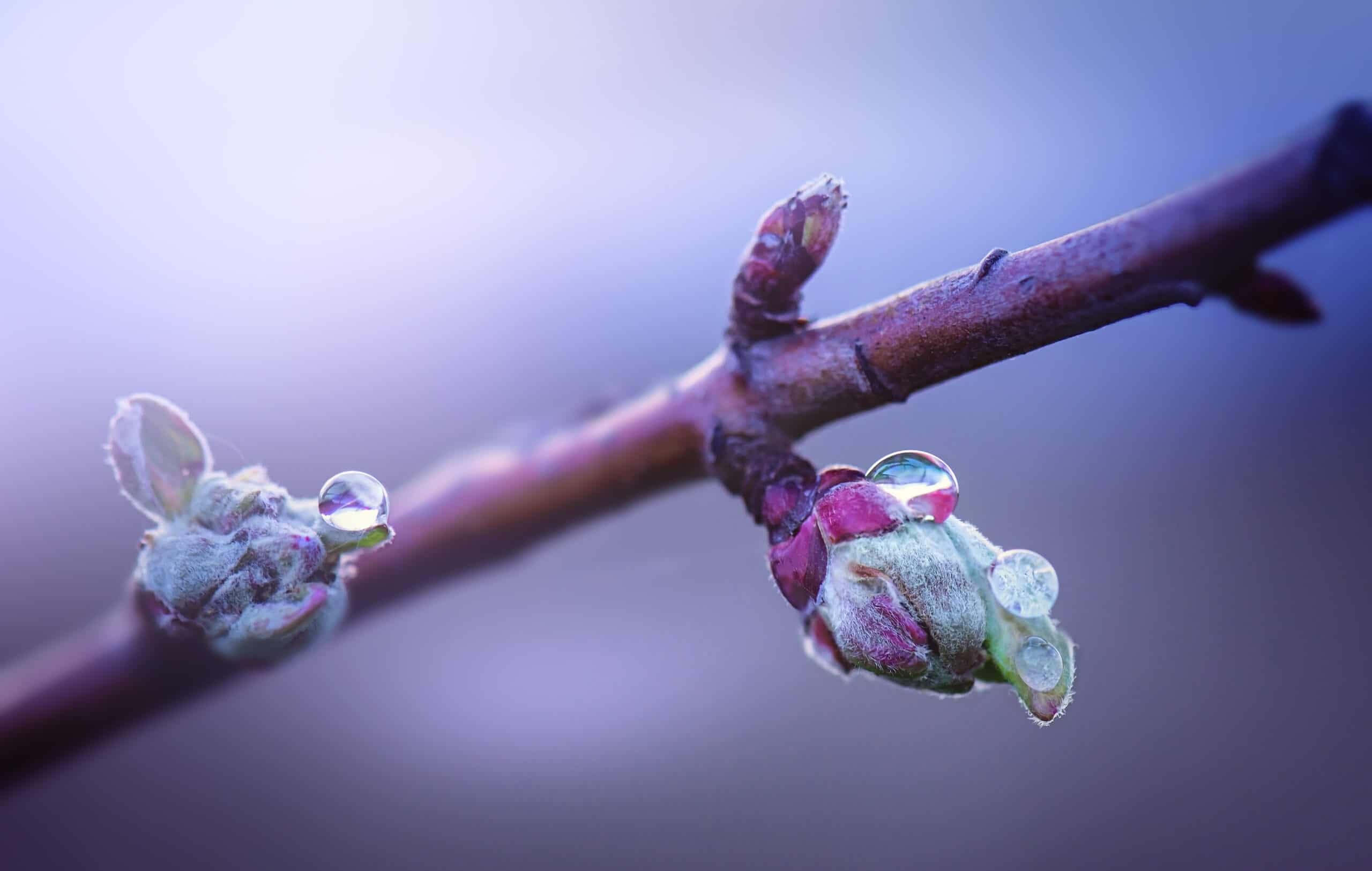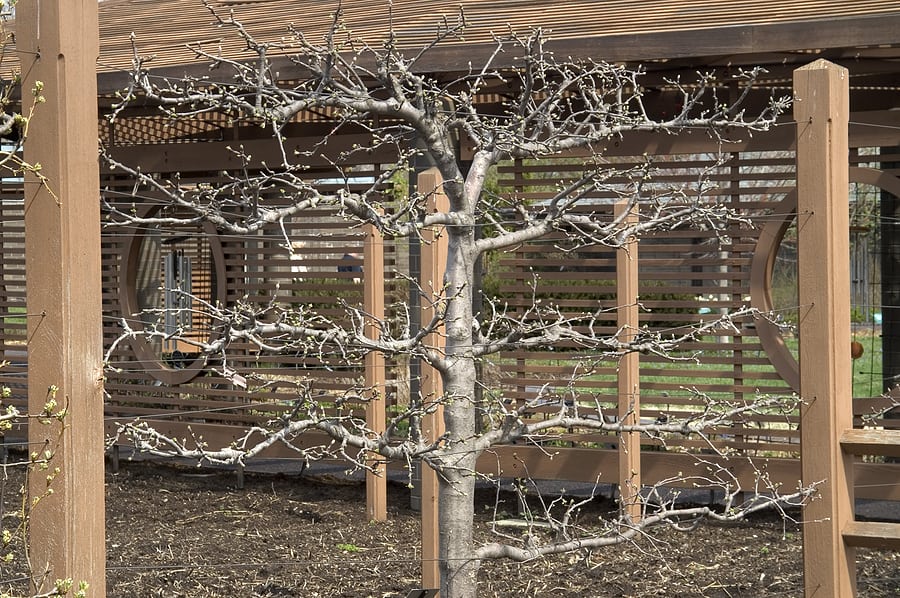 Chill hours are the number of cold hours or days that a deciduous fruit tree (or nut tree) requires for flowering and fruit production each year. Every fruit tree variety has its own number of hours of chill needed for fruit production. Some fruit trees need as few as 100 chill hours, others need as many as 1,000 chill hours or more.
Chill hours are the number of cold hours or days that a deciduous fruit tree (or nut tree) requires for flowering and fruit production each year. Every fruit tree variety has its own number of hours of chill needed for fruit production. Some fruit trees need as few as 100 chill hours, others need as many as 1,000 chill hours or more.
Apples, peaches, and apricots are fruit trees most affected by chill hours. Apples have the highest chilling requirements of all fruit trees, followed by apricots and, then, peaches.
‘Fuji’ and ‘Gala’ apple varieties require 900 chill hours; ‘Dorset Golden’ apple requires just 100 chill hours. ‘Dorset Golden’ can be grown in southern Florida but ‘Fuji’ and ‘Gala’ cannot—the winters are too mild.
Figs, olives, and quince have the lowest chill requirements, followed by persimmons, pomegranates, almonds, and chestnuts. Apples, apricots, cherries, peaches, and plums have higher chill hour requirements.
When choosing a fruit tree, it is important to choose a tree that can grow fruit where you live. You must be sure to choose a tree with a chill hours requirement that matches the number of hours or days of chill or cold where you live.
A fruit tree may grow well where winters are mild, but if there are not enough chill hours over the course of winter, the tree will not fruit properly. If a tree bears fruit after a cold winter but then produces little or nothing after a mild winter, the tree is likely not a good match for the local climate. You can do everything right for a fruit tree—the right water and fertilizer, but if the climate and chill hours are not a good match, the tree will not produce.
The optimum chill gathering temperature ranges from 34° to 48°F. Fruit trees can gain chill hours when the temperature is continuously between 34° and 48°F, but a tree can lose chill hours when the weather warms and the temperature rises above 48°F. If the temperature stays cold chill hours accumulate. If the weather vacillates between cold and warm, chill hours will not accumulate.
Check the chill hours of the fruit tree you want to grow. For example, ‘Desert Gold’ peach tree needs 300 chill hours each year; ‘Red Haven’ peach tree needs 950 chill hours each year. Make sure there are enough chill hours where you live to grow the variety you want to grow.
To know the average number of chill hours in winter where you live contact the nearby Cooperative Extension Service or a Master Gardener group. You can also find chill hours for many locations online. Chill hour estimates for locations are averages; some winters can be colder or warmer than others, but the number of chill hours a particular fruit variety needs will be constant.
The number of chill hours a fruit tree needs often appears in nursery catalogs online.

Chill Hours Explained
Fruit trees develop next year’s flower buds in the summer (flowers that are pollinated become fruit). When autumn comes buds become dormant as days lengthen and temperatures cool. Healthy dormancy is triggered by a certain minimum exposure to cool and cold temperatures—chilling hours. If the number of chill hours is not accumulated in winter, bud break, flowering, and fruiting can be delayed or interrupted the next spring. (Cold and warm temperatures affect hormones and chemicals in the plant that regulate the length of dormancy and the time and fullness of bud break in spring; dormancy is needed by plants to survive winter cold and conserve energy for the next growing season. The hormone that regulates dormancy is regulated by chill hours and warming temperatures in spring.)
There are several models for determining chilling hours, but the simplest is: one chilling unit (CU) is equal to one hour’s exposure to the chilling temperature; these units are added up and totaled for a whole season. Advanced models assign different weights to different temperature bands, for example, for any hour colder than 34.5 degrees there is no chilling; for any hour between 34.6F and 36.4F there is a half-hour of chill; for any hour between 36.5F and 48.4F there an hour of chill is added; for any hour between 61.0Fand 64.4F, there is a half-hour of chill hour loss.
Once dormancy is reached in autumn or early winter it cannot be reversed by short-term warm temperatures, but if warm temperatures persist, dormancy can be broken; if that happens without sufficient accumulated chill hours, bud break may be delayed, buds may not break or maybe damaged which in turn will affect fruit set and production.
How to Figure the Monthly Average or Mean Temperature and Chill Hours
Here’s how the average or mean temperatures is calculated each month:
- The maximum temperatures each day of the month are added together and divided by the number of days in the month to get the average maximum temperature for the month.
- The low temperatures for each day of the month are added together and divided by the number of days in the month to get the average minimum temperature for the month.
- The average monthly maximum and minimum temperatures are added together and divided by two; the result is the monthly average or mean temperature.
Here are the hours of chill for several monthly average or mean temperatures: 46°F, 988 chill hours; 48°F, 883 chill hours; 50°F, 779 chill hours; 52°F, 675 chill hours; 54°F, 575 chill hours; 56°F, 475 chill hours; 58°F, 355 chill hours, 60°F, 288 chill hours; 62°F, 200 chill hours; 64°F, 118 chill hours; 66°F, 58 chill hours; 68°F, 0 chill hours. Chill hours are not accumulated when the temperature is less than 35°F or greater than 68°F.
Low Chill Hours Fruit Trees
If you are unsure of the chill hours where you live, plant a tree with a low chill hours requirement.
Here are some fruit trees that need low chill hours:
- Apples: ‘Dorsett Golden’ (100 hours or less); ‘Fuji’ (200 to 400 hours); ‘Pink Lady’ (200 to 400 hours).
- Apricots: ‘Autumn Glo’ (500 hours); ‘Flora Gold’ (400 hours) ‘Katy’ (200 to 300).
- Cherries: ‘Minnie Royal’ (200 to 300 hours); ‘Royal Lee’ (200 to 300 hours).
- Nectarines: ‘Arctic Star’ (300 hours); ‘Double Delight’ (400 hours); ‘Snow Queen’ (200 to 300 hours).
- Peaches: ‘August Pride’ (300 hours); ‘Donut’, also called ‘Saturn’ (300 hours or less); ‘Eva’s Pride’ (100 to 200 hours); ‘Mid Pride’ (250 hours or less); ‘Red Barron’ (200 to 300 hours).
- Plums: ‘Burgundy’ (150 to 300 hours); “Methley” (250 hours).
Also of interest:
How to Grow Peaches and Nectarines















